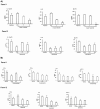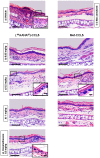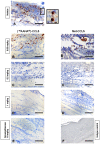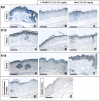Therapeutic efficacy and immunological response of CCL5 antagonists in models of contact skin reaction
- PMID: 20090949
- PMCID: PMC2806914
- DOI: 10.1371/journal.pone.0008725
Therapeutic efficacy and immunological response of CCL5 antagonists in models of contact skin reaction
Abstract
Skin-infiltrating T-cells play a predominant role in allergic and inflammatory skin diseases such as atopic dermatitis, psoriasis and allergic contact dermatitis. These T-cells are attracted by several chemotactic factors including the chemokine CCL5/RANTES, a CC chemokine inducing both the migration and activation of specific leukocyte subsets. CCL5 has been found to be associated with various cell-mediated hypersensitive disorders such as psoriasis, atopic dermatitis and irritant contact dermatitis. We have used two antagonists, the first, Met-CCL5, a dual CCR1/CCR5 antagonist and the second, a variant in which GAG binding is abrogated, (44)AANA(47)-CCL5, which acts as a dominant negative inhibitor of CCL5. The antagonists were tested in two models of contact skin reaction. The first, irritant contact dermatitis (ICD) is a pathological non-specific inflammatory skin condition arising from the release of pro-inflammatory cytokines by keratinocytes in response to haptens, usually chemicals. The second, contact hypersensitivity (CHS) is a T-cell dependent model, mimicking in part the T-cell-mediated skin diseases such as psoriasis. In both models, the CCL5 antagonists showed therapeutic efficacy by reducing swelling by 50% as well as the reduction of soluble mediators in homogenates derived from challenged ears. These results demonstrate that blocking the receptor or the ligand are both effective strategies to inhibit skin inflammation.
Conflict of interest statement
Figures







Similar articles
-
Reduced 2,4-dinitro-1-fluorobenzene-induced contact hypersensitivity response in IL-15 receptor alpha-deficient mice correlates with diminished CCL5/RANTES and CXCL10/IP-10 expression.Eur J Immunol. 2005 Mar;35(3):690-8. doi: 10.1002/eji.200425577. Eur J Immunol. 2005. PMID: 15719370
-
TARC and RANTES, but not CTACK, are induced in two models of allergic contact dermatitis. Effects of cilomilast and diflorasone diacetate on T-cell-attracting chemokines.Br J Dermatol. 2004 Oct;151(4):823-30. doi: 10.1111/j.1365-2133.2004.06220.x. Br J Dermatol. 2004. PMID: 15491423
-
A GPR40 agonist GW9508 suppresses CCL5, CCL17, and CXCL10 induction in keratinocytes and attenuates cutaneous immune inflammation.J Invest Dermatol. 2011 Aug;131(8):1660-7. doi: 10.1038/jid.2011.123. Epub 2011 May 19. J Invest Dermatol. 2011. PMID: 21593768
-
[Functions of prostaglandin receptors in contact dermatitis and application to drug discovery].Yakugaku Zasshi. 2012;132(11):1217-23. doi: 10.1248/yakushi.12-00232-2. Yakugaku Zasshi. 2012. PMID: 23123710 Review. Japanese.
-
Immunological mechanisms of contact hypersensitivity in mice.APMIS. 2012 Jan;120(1):1-27. doi: 10.1111/j.1600-0463.2011.02832.x. Epub 2011 Nov 11. APMIS. 2012. PMID: 22151305 Review.
Cited by
-
Enhancement of Chemokine mRNA Expression by Toll-Like Receptor 2 Stimulation in Human Peripheral Blood Mononuclear Cells of Patients with Atopic Dermatitis.Biomed Res Int. 2020 Mar 19;2020:1497175. doi: 10.1155/2020/1497175. eCollection 2020. Biomed Res Int. 2020. PMID: 32280674 Free PMC article.
-
Topical hypochlorous acid (HOCl) blocks inflammatory gene expression and tumorigenic progression in UV-exposed SKH-1 high risk mouse skin.Redox Biol. 2021 Sep;45:102042. doi: 10.1016/j.redox.2021.102042. Epub 2021 Jun 11. Redox Biol. 2021. PMID: 34144392 Free PMC article.
-
Toll-like receptor 3 increases allergic and irritant contact dermatitis.J Invest Dermatol. 2015 Feb;135(2):411-417. doi: 10.1038/jid.2014.402. Epub 2014 Sep 17. J Invest Dermatol. 2015. PMID: 25229251
-
The Role of Post-Translational Modifications of Chemokines by CD26 in Cancer.Cancers (Basel). 2021 Aug 24;13(17):4247. doi: 10.3390/cancers13174247. Cancers (Basel). 2021. PMID: 34503058 Free PMC article. Review.
-
The Role of Chemokines in Psoriasis-An Overview.Medicina (Kaunas). 2021 Jul 26;57(8):754. doi: 10.3390/medicina57080754. Medicina (Kaunas). 2021. PMID: 34440960 Free PMC article. Review.
References
-
- Pastore S, Mascia F, Mariotti F, Dattilo C, Girolomoni G. Chemokine networks in inflammatory skin diseases. Eur J Dermatol. 2004;14:203–8. - PubMed
-
- Johnson Z, Kosco-Vilbois MH, Herren S, Cirillo R, Muzio V, et al. Intereference with Heparin Binding and Oligomerization Creates a novel Anti- Inflammatory Strategy targeting the Chemokine System. The J of Immunology. 2004;173:5776–85. - PubMed
-
- Proudfoot AE, Fritchley S, Borlat F, Shaw JP, Vilbois F, et al. The BBXB Motif of CCL5 Is the Principal Site for Heparin Binding and Controls Receptor Selectivity. The Journal of Biological Chemistry. 2001;276:106–20. - PubMed
-
- Nomura I, Gao B, Boguniewicz M, Darst MA, Travers JB, et al. Distinct patterns of gene expression in the skin lesion of atopic dermatitis and psoriasis: a gene microarray analysis. J Allergy Clin Immunol. 2003;112:1195–1202. - PubMed
-
- Asadullah K, Volk HD, Sterry W. Novel immunotherapies for psoriasis. TRENDS in Immunology. 2002;23:47–53. - PubMed
Publication types
MeSH terms
Substances
LinkOut - more resources
Full Text Sources
Other Literature Sources
Miscellaneous

